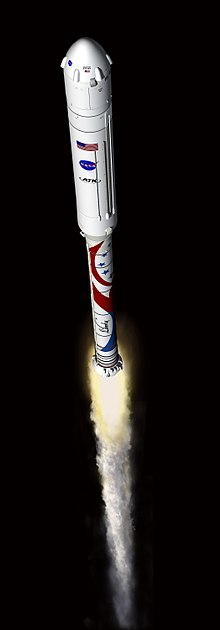This rocket article contains payload capacity, but does not include orbital altitude or inclination, which greatly affects the capacity. |
 Artist's conception | |
| Manufacturer | Northrop Grumman Space Systems Airbus Defence and Space |
|---|---|
| Country of origin | United States Europe |
| Size | |
| Height | 300 ft (90.00 m) |
| Diameter | 18 ft (5.40 m) |
| Stages | 2 |
| Capacity | |
| Payload to LEO | |
| Mass | 44,500 lb (20,000 kg) [1] |
| Associated rockets | |
| Family | Preceded by Ares I Followed by OmegA |
| First stage | |
| Powered by | 5-segment Shuttle-derived Solid Rocket Booster |
| Propellant | Solid |
| Second stage | |
| Powered by | 1 × Vulcain 2 |
| Maximum thrust | 301243 pounds (1,340 kN)[2] |
| Specific impulse | 431 seconds (vacuum)[2] |
| Burn time | 650 seconds[2] |
| Propellant | LOX/LH2 |

Liberty was a 2011 launch vehicle concept proposed by ATK (now part of Northrop Grumman Space Systems via the acquisition of Orbital ATK) and Airbus Defence and Space (formerly Astrium) for phase 2 of the NASA Commercial Crew Development (CCDev) program intended to stimulate development of privately operated crew vehicles to low Earth orbit.
Similar to the defunct Ares I project, which consisted of a five segment Space Shuttle Solid Rocket Booster (SRB) and a new cryogenic second stage, Liberty would combine a five-segment SRB with the core stage of the European Ariane 5 as a second stage. It was intended to be launched from Kennedy Space Center.[3][4]
Liberty was proposed as a vehicle to service the International Space Station for crew and cargo, but its capacities could potentially have allowed for government and commercial satellite launches, including to Geostationary transfer orbit.[5]
The launcher was proposed to be 300 feet (91 m) in height, with an advertised price of $180 million per launch. Liberty had a projected payload of 44,500 lb (20,000 kg) to Low Earth orbit.[4]
- ^ "ATK breathe life into Liberty via unfunded NASA Space Act Agreement". 14 September 2011.
- ^ a b c "Volvo Aero: Vulcain 2 - characteristics". Volvo Aero. Retrieved 2007-05-12.
- ^ Canceled NASA Rocket Could Return as Part of Low-Cost Space Taxi
- ^ a b "ATK and Astrium Unveil the Liberty™ Launch Vehicle Initiative". ATK. Archived from the original on 2011-07-17. Retrieved 2011-04-09.
- ^ "Alliant, EADS Unit Set Sights on Rocket Venture". Wall Street Journal. 2011-02-08. Retrieved 30 January 2012.